Although I have been riding for quite a while now, I still remember taking the MSF course like it was yesterday.
Being determined to pass, I spent hours of research just trying to figure out what to wear.
After studying endless websites and forums, and ultimately passing my own MSF without issue, I’m confident that you should wear the following gear to the MSF:
- DOT-approved Helmet
- Eye Protection
- Full fingered gloves
- Over-the-Ankle Boots or Shoes
- Long Sleeve Shirt or Jacket
- Jeans or Heavy Pants
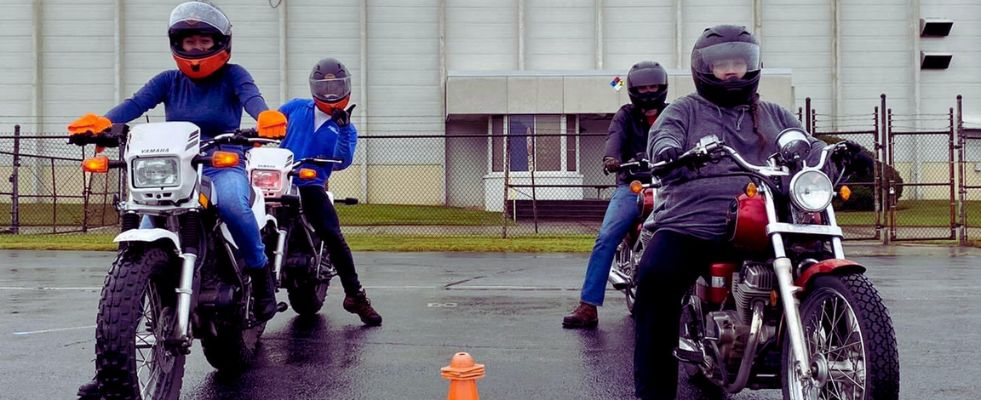
Believe it or not, what you wear to the MSF course can play a huge role in your success during and after the course. You can even fail the MSF course if you’re not wearing the correct gear.
Here are a few things to keep in mind when choosing gear for the MSF and a few tips to ensure you’re fully prepared for the MSF.
What to Wear
It’s always a good idea to check the official guidelines for the course you sign up for, however, based on my research and personal experience, here are the 6 pieces of gear the MSF requires you to wear.
I also added a few ninja tips to help you understand the how and why behind the gear.
1. DOT-approved Helmet
The first and most important thing to wear to your MSF course is a motorcycle helmet. And this one deserves the most mention for a few reasons.

You can’t just wear any helmet, the MSF requires you to wear either a full-face or 3/4 shell helmet. And it must be DOT-approved, with the DOT sticker easily visible on the back.
This also means no half-shell helmets or skull caps.
Some schools actually provide helmets for students, however, it is still recommended that you bring your own.
There is a chance they will be limited in supply and size selection. Plus, who knows how many heads these helmets have been through?
If you do decide to get your own helmet for the course, here are a few tips for making sure you pick the right one.
a. Get the Right Fit
Fit is the most crucial aspect of a motorcycle helmet, especially for newer riders who are just now adjusting to wearing something this bulky on their head.
The protection a motorcycle helmet provides depends on how well it fits the size and shape of your head. Not only that, Fit plays the biggest role in the overall comfort of the helmet.
A helmet that fits too small will quickly start to apply pressure on your head and can easily bring on a headache.
One that is too big can move around on your head and cause your neck and shoulder muscles to work overtime.
You want to be able to focus on the MSF drills without worrying about a headache or that crazy burning sensation in your neck.
b. Get the Right Size
Size kind of ties into Fit but really deserves its own mention.

As I said, riders who are taking the MSF course are just now getting used to having such a heavy helmet on their head.
Even with the right fit, there is a good chance you will be a little sore until you get fully adjusted to the helmet.
Making sure you have the right size helmet will help you avoid any unnecessary weight on your neck and shoulders.
c. Don’t Overspend
As a beginner, your helmet will likely be your most expensive purchase. But don’t think you need to spend $500 on a helmet.
In fact, I don’t recommend spending too much on your helmet for the course.
The MSF does a good job of showing you what you’re getting into with motorcycling, and for some new learners, this is enough for them to realize that motorcycling is not for them.
You don’t want to invest a lot of money into the course with the risk of finding out that motorcycling is not your thing.
If you stay within a lower budget, you can avoid wasting even more money than you already put out for the course and gear.
d. Don’t Underspend
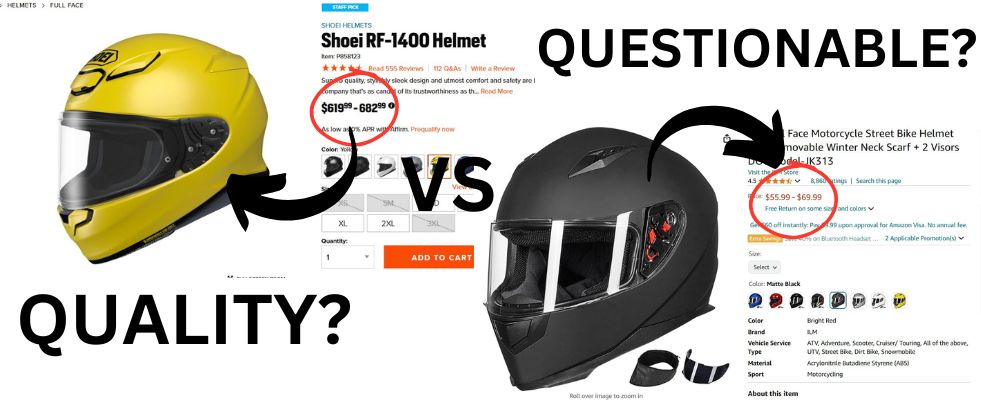
As a counter to overspending, you also don’t want to underspend. Just like the old saying “You get what you pay for”, motorcycle helmets are no different.
A lot of the cheaper helmets come with larger shells, fewer features, and worse aerodynamics than the more quality helmets.
Not only can this cause discomfort during the MSF, but it also becomes 10x worse when you get out on the road riding at regular speeds. This causes a lot of riders to upgrade their helmet shortly after buying the first one.
If you do decide to keep riding after the MSF, buying a quality helmet will give you comfort during the course and will prevent you from forking out even more money for a better helmet down the road.
e. Pick a Bright or Hi-vis Color
Want to really impress your MSF instructors? Buy a bright-colored or hi-vis motorcycle helmet.
It is no secret that motorcycles can be hard to see on the road. This is why most schools and professionals recommend motorcyclists wear bright colors.
Ryan F9 mentions this in his video Invisibility Training. If the cars can see you, they will be less likely to pull in front of you, causing a wreck.
In a world where it’s easy to buy all-black gear, buying a hi-vis or brightly colored helmet will signal to your instructors that you are serious about learning and safety.
And as lovers of the sport, there’s a good chance they will be rooting for you to pass even more.
If you can’t tell, I ended up making a lot of these mistakes.
The helmet I bought for the MSF was too big and I didn’t realize until 20 minutes into the MSF drills when the tell-tale symptoms went from 0 to 100.
And although it was cheap, it was so uncomfortable and ill-fitting that I was ready to upgrade within the first month of riding.
Whichever helmet you decide to go with, as long as it is DOT-approved and at least 3/4 shell to full-face, you will be good to take the course.
But for extra measure, try to make a visit to your local motorcycle store or Cyclegear. The staff there can make sure you pick a helmet that fits perfectly while also being within budget.
For a full breakdown on which helmet to get, check out this article on how to choose a motorcycle helmet.
2. Eye Protection
The MSF requires that you wear some form of Eye Protection during the course. This is the one piece of gear that definitely deserves an asterisk.

For the riders who decide to use a full-face helmet, this step is already covered by the front visor on the helmet. But for the riders that decide to use a 3/4 shell, you have to wear some sort of eye protection.
At the most, this will require a set of goggles, but some schools will let you wear your standard set of eyeglasses or even sunglasses.
This is why I recommend you check with the school or instructors hosting your MSF course. They will let you know if you need full-fledged goggles or if you can wear standard glasses or sunglasses.
Whichever you decide, make sure they do not obstruct your vision in any way.
During the MSF, you will be relying on your good vision and ability to look around quite a bit. Having a set of goggles that get in the way is going to make you have a rough time completing the drills.
3. Full-fingered gloves
The next thing to make sure you wear to the MSF is a pair of full-fingered gloves.

Unfortunately, you cannot wear fingerless gloves, your hand must be covered from wrist to finger.
And just like your helmet, your gloves play a surprisingly important role in how well you do in the MSF.
If you want to a breakdown of what to look for, check out out guide on how to choose Motorcycle Gloves.
Firstly, they are another part of keeping you protected on the bike.
Our hands are usually the first thing to take damage in the event of a fall, as we instinctually try to catch ourselves with our hands.
As well, during the MSF you’ll be learning the feel and nuance of the throttle, clutch, and front brake. All these things deal with the articulation you have on the bars and controls.
Not only do gloves provide you with protection, but they also allow you to interact with the controls in a way that gives you the smooth, controlled inputs you need to learn.
Here are a few tips for making sure to pick a good set of gloves for the MSF course:
a. Get the Right Fit
Just like your helmet, your gloves must be a solid fit.
Gloves that are too small will limit your range of motion, causing you to have trouble reaching the controls and using the articulation of your wrist. They can also become increasingly uncomfortable throughout the course.
Gloves that are too big will limit your feel and movement on the controls. This can cause those same jerky movements and make it hard to know where your hands are on the bars and levers.
b. Use Motorcycle-specific Gloves
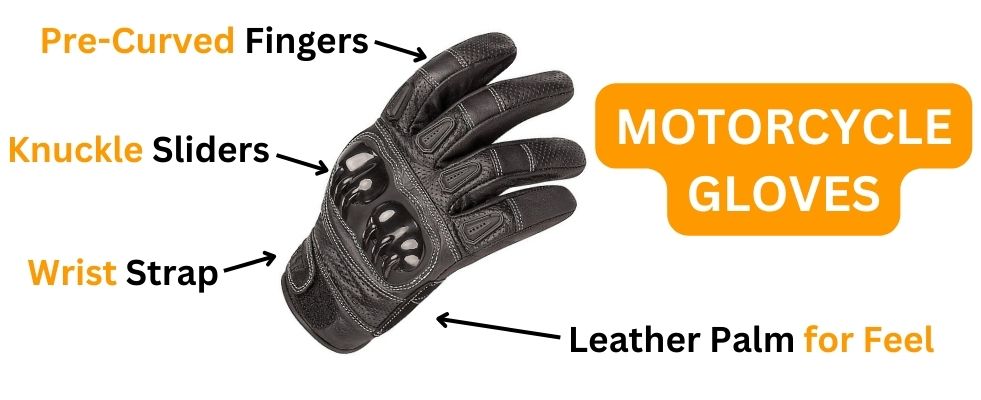
While you can use a work glove or similar style glove, I still recommend using a motorcycle-specific glove.
These gloves tend to have pre-curved fingers so you can easily pull the levers without tiring.
This is great because as newer riders, you are still building up those hand and forearm muscles. They also tend to have some type of leather or similar material on the palm.
This material is surprisingly important as it provides the best feel for your hand on the throttle and bars.
As long as you have a full-fingered set of gloves, you should be in good shape.
If you need a full breakdown on which gloves to buy, check out this article on how to choose motorcycle gloves.
4. Over-the-ankle boots or shoes
Another really important requirement for the MSF course is a pair of sturdy over-the-ankle boots or shoes.

In the event of a fall, it is easy for a motorcycle to pin your leg to the ground.
Even if you’re not moving, having a 200-pound piece of metal fall on your leg could mean trouble for your foot and ankle.
Tall boots protect your foot and ankle from the impact of the motorcycle in the event of a tip-over.
And if you fall over at speed, they can protect you from hyper-extending your ankle, since they restrict ankle movement to a degree.
Here are a few rules I recommend you keep in mind when it comes to choosing boots or shoes for the MSF course:
a. Thick soles
Try to choose a boot or shoe with thick soles.
Not only will this provide good support during the exercises, but it also prevents your feet from getting sore as you get used to the foot pegs.
b. Good Grip
During the MSF, you will be learning foot placement on the pegs, while learning to shift and brake.
Having a good grip will help you feel connected and confident on the motorcycle. It will also help you easily return to the foot pegs after braking or shifting.
c. Avoid Tall Heels
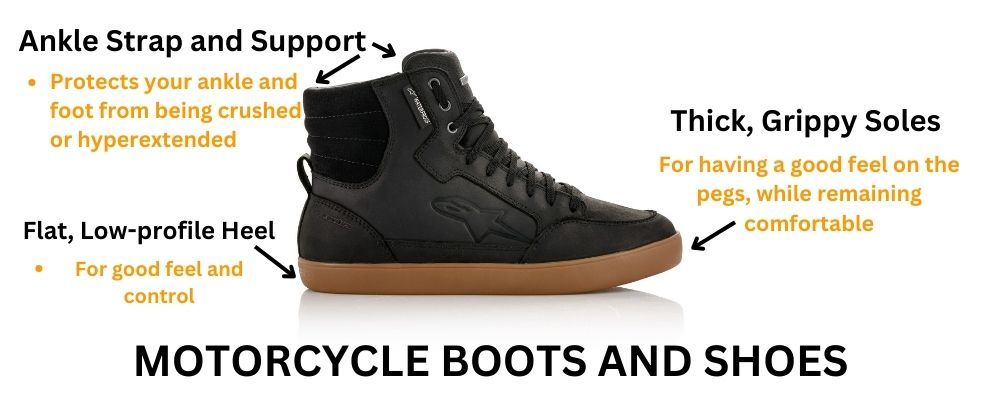
The heel of your boot can easily catch the foot peg as you slide your feet forward and backward to brake or shift.
This can cause newer riders to mess up or get nervous about foot placement or shifting and braking.
Tall heels can make it even harder for newer riders to learn the foot controls of a motorcycle.
d. Avoid Bulky Boots
You also want to avoid any boot that is too large for your feet or too bulky.
As a new rider, you will just be learning foot placement and how to shift.
Bulky boots can make it hard for you to fit your foot under the shift lever and will also make you feel less stable on the bike.
e. Avoid Steel-Toe Boots
Although steel-toe boots are strong, they are not a good choice for motorcyclists, especially beginner riders.
Steel-toe boots tend to be bulky and can prevent you from feeling the shift lever.
This can make it even harder for a new rider to learn how to operate a motorcycle.
I ended up going with a cheap pair of Bilt motorcycle shoes. While not as sturdy as a boot, they were still as sturdy as a regular shoe and covered my ankles.
If you stick to these recommendations, you have good footwear for the MSF course.
For a detailed breakdown, check out this article on how to choose motorcycle boots.
5. Long Sleeve Shirt or Jacket
The next thing you need to wear to your MSF course is a long-sleeved jacket or shirt.

This one also deserves an asterisk, as the MSF courses are usually pretty lax on what you wear.
From my research and experience, all you are required to wear is a long sleeve shirt. Some courses do require a jacket but it’s rare that it’s mandated.
As long as it covers the entirety of your arm, you should really pick a long-sleeve or jacket based on the weather during your MSF course.
If it’s hot, feel free to wear a light long-sleeve shirt. For cold or rainy days, a jacket may be more appropriate.
Try to avoid wearing anything inappropriate for the weather as it could distract you or cause you discomfort throughout the course.
For extra credit, you can find a good mesh motorcycle jacket with padding for around $100. These can provide the best of both worlds.
For a detailed breakdown of motorcycle jackets, check out this guide on how to choose a motorcycle jacket.
6. Jeans or similar strength pants
Finally, the MSF requires you to wear jeans or pants of similar strength during the course. Unfortunately, this means no leggings for the ladies and no sweatpants for the guys.

Luckily there is not much to this piece of gear. As long as your jeans or pants fit, you should be good to go. But just in case, here are a few things to consider:
a. Not Too Small
Your jeans should completely cover your legs from the waist to the ankle. More importantly, they should completely cover your legs when you’re in the seated position. If they are too small or tight, they do not provide you with the protection needed – plus, they can even limit movement and cause discomfort during the course.
b. Not Too Big
In addition to small jeans, having jeans that are too big can cause you trouble. Not only will this be uncomfortable to manage, but the extra jean material could also get in your way when you’re moving your legs around the bike and controls.
Whatever pants you decide to wear, as long as they are similar in strength to jeans and fully cover your legs in the seated position, you will have a good pair for the MSF.
For more information, check out this guide on how to choose motorcycle pants.
How to Choose Gear For the MSF
Choosing gear for the MSF course doesn’t have to be stressful.

And as long as you follow the requirements outlined by the course you signed up for, you should be good to go.
However, here are a few things to keep in mind when choosing your gear for the MSF.
1. Follow Your Course’s Requirements
The first and most important step is to always follow the gear requirements outlined by the course you are taking.
While all courses follow the MSF guidelines, most classes or instructors will email you a confirmation letter along with the gear requirements for the class.
Whatever you do, make sure you take this seriously, as you can quickly fail the MSF course if you do not show up in the required gear.
2. Get a Good Fit
Making sure your gear fits correctly is just as important as the gear itself. Not only for comfort’s sake but for protection as well.
Gear that is too small may not cover you completely, even worse, it may restrict your movement during the course – causing you to struggle through the drills.

Gear that is too big could get in the way or catch on to something, making you struggle to keep focus or with the drills.
Make sure you test the fit of your gear from a seated position with your hands stretched forward, as this is the position you will be in on the motorcycle.
If your pants rise up to your shins when you sit down, it may be time to get a longer length. If your midriff comes out every time you extend your arms, you may need to find a longer jacket.
3. Confidence-Inspiring Gear
Finally, the gear you wear for the MSF should be confidence-inspiring.
Good gear will give you the sense that you are protected, which will give you a level of confidence on the bike.
Knowing you are protected will allow you to put all your focus on the life-saving drills taught in the MSF course.
Cost of Gear for the MSF Course
When it comes to getting the gear, some people are lucky enough to have a friend or relative who rides.
If that’s the case, there’s a good chance they will loan you a few items so you can take the course.
For the rest of us, we will probably end up buying new gear.
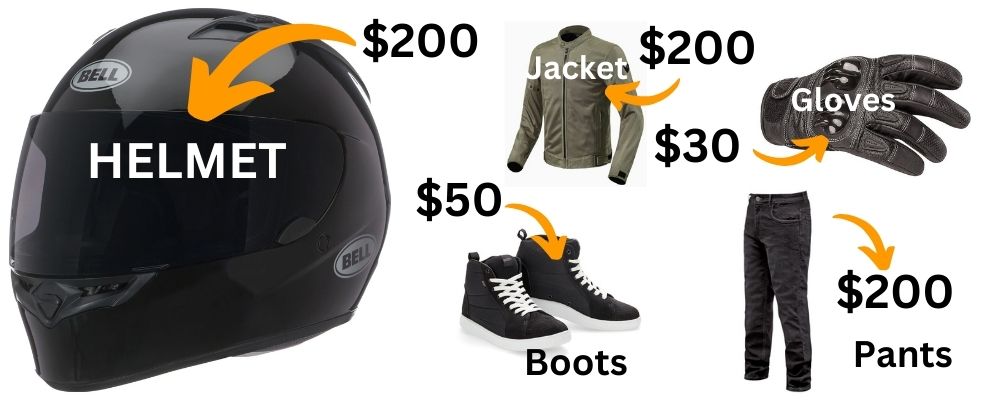
But the good news is that you don’t have to spend an arm and leg buying gear.
There are a lot of entry-level options that won’t break the bank.
Here are a few recommendations as well as some estimates of what you can expect to spend on gear for the MSF course.
- Helmet = $100-$200 (HJC i10 helmet = $160)
- Motorcycle Shoes = $50 (BILT Dexter Shoes = $50)
- Gloves = $25-$40 (BILT Spirit 2 Gloves = $20)
- Jacket* = $100-$150 (BILT Blaze 2 Jacket = $120)
There’s a good chance you already have a pair of jeans for the course, but I also excluded the cost of goggles and put an asterisk by the jacket.
Often these items are covered or not required for the course.
Regardless if you’re borrowing gear or buying new, make sure everything fits well and fulfills the guidelines set by your MSF course.
Conclusion
Gear is important, it is our only form of protection on a motorcycle, no airbags, seatbelts, or cages to protect your person.
Gear can be a deciding factor whether you fail, pass, or even participate in the MSF course. If you are planning to take the course or already signed up, I hope this article helps you pass the MSF course.

